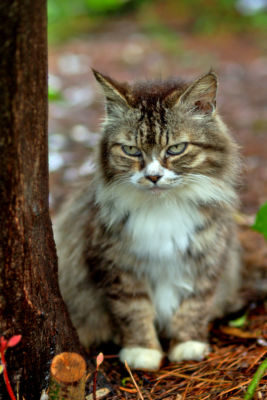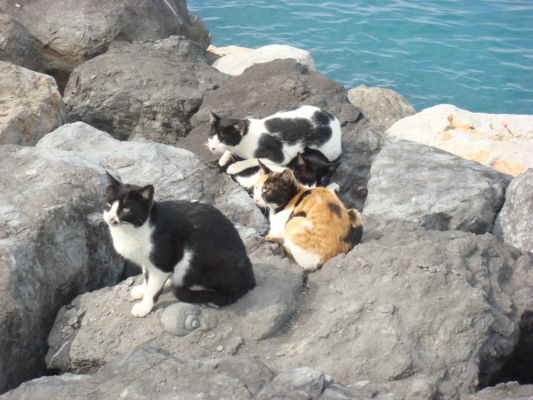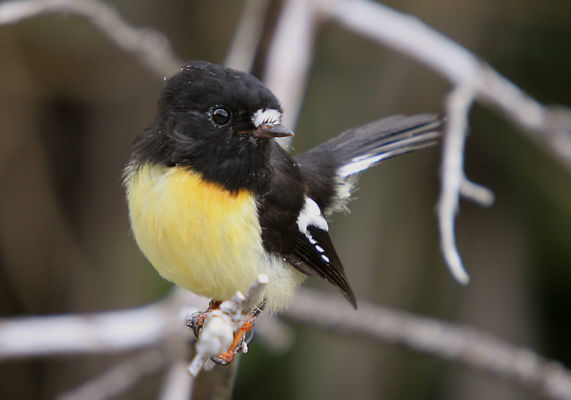While PFNZ Trust focuses on 5 key introduced predator species (possums, rats, ferrets, stoats and weasels), we acknowledge that domestic pets – both cats and dogs – are also introduced predators and are potential killers of native wildlife if allowed to stray. Wandering dogs can and do kill kiwi and penguins when they encounter them. A single dog on a single night can devastate a penguin colony. The extent to which pet cats, stray cats and feral cats kill smaller native birds is the subject of ongoing research in New Zealand and around the world.

One such study was published last year in the New Zealand Journal of Ecology and looked at pet cats living in Oban township on Stewart Island, 5km from the Rakiura National Park boundary. Using VHF radio collars, the researchers tracked how far pet cats wandered from their homes over a 28 day period. Cat owners also logged prey species their pets brought home over a 6 month period.
The research was carried out by Vanessa Wood, Phillip Seddon, Brent Beaven and Yolanda van Heezik and, although recently published, was based on field work carried out in 2005. The research began with a survey on cat ownership delivered to Stewart Island residents.
“The survey yielded a low response, with only 17 (c. 7%) of 168 distributed surveys returned, and 11 owners willing to participate in both the prey item and radio-tracking studies. The total number of domestic house cats in Halfmoon Bay is unknown but estimated to be approximately 100. Fifteen cats (9 neutered males, 1 unneutered male, and 5 spayed females) were followed, with three cats belonging to the same household. All cats were healthy and in good condition.”
Most cats, surprisingly, stayed home. But even those that do stay home or close to home on Stewart Island have some access to native birdlife. Cats that did go further afield, tended to be younger individuals.
“Home range size varied from 0.05 ha (an arbitrary value assigned to cats that never left their properties, denoting a typical property size including house and garden) to 16.58 ha, with a median value of 0.05 ha, and a mean value of 1.74 ha (SD = 4.33 ha). Only six cats moved away from their property, three of which had a home range greater than 1.5 ha: five of these were the youngest of the 15 sampled.”

Wandering activity peaked between 5am and 7am and the furthest distance recorded for a single cat was 441 m. Even the most persistent wanderers tended to be home again from 8am-11am (breakfast time, perhaps?) and again from 2pm-4pm.
As well as being ‘stay-at-homes’, the majority of the cats in the study didn’t appear to be motivated hunters – with one notable exception.
“During the six months of data collection, participating owners recorded a total of 27 prey items from four cats; the other 11 cats did not bring home any prey. A single cat brought home 63% of all recorded prey items (13 rats, three tomtits, and one blackbird), and the other 37% of prey comprised five rats, two house sparrows and three song thrushes. Rats were the most frequently brought home prey item (67% of all prey brought home) and were caught by three of the four cats. The majority of the birds brought home were juveniles, with the exception of one adult blackbird. Tomtits were the only native species brought back.”
The Stewart Island cats seem to have been less active hunters than cats in other urban studies in New Zealand and around the world. Research by others has, however, shown that prey brought home by cats can be as little as 1/4 of what they actually catch.

“Rats were taken by three of the four cats that brought prey home, and made up two-thirds of all prey recorded. Both ship rats (Rattus rattus) and Norway rats (R. norvegicus) are relatively common on Rakiura, and form the primary prey of feral cats on the island. Given that rats are also significant predators of native wildlife, it is possible that cats may play an important role in controlling rat populations. However, the most active hunter in the study caught three native tomtits as well as 13 rats.”
While the researchers acknowledge that limitations of the radio tracking study probably meant the actual movement of domestic cats was underestimated, the good news is that domestic cats in Oban were very unlikely to travel the 5km necessary to cross into the nearby national park. Feral cats, however, travel over much larger ranges, may live permanently within the national park boundary and are a very different issue.
The full article is published in the New Zealand Journal of Ecology and is freely available online.
Movement and diet of domestic cats on Stewart Island/Rakiura, New Zealand (2016)

